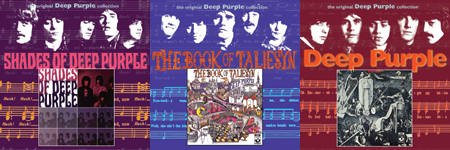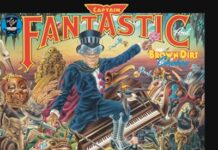Before the lineups that made “Smoke On The Water” and “Burn,” the original Deep Purple recorded three glorious albums, setting the foundation for what the band would eventually blossom into — a legendary, world-class hard rock unit. The May 1968 debut LP, Shades Of Deep Purple, the follow-up six months alter, The Book Of Taliesyn, and the 1969 self-titled third album have been given a new life from Eagle Records — repackaged and embellished with bonus tracks of B-sides, studio outtakes and BBC jams.
While certainly capable of writing their own songs, Deep Purple was often referred to as England’s answer to Vanilla Fudge because of the choice covers they included in their repertoire. This is certainly the case of their first two albums — Shades Of Deep Purple and The Book Of Taliesyn — which contain two of Deep Purple’s three Top 40 singles. So while Shades of Deep Purple starts off promisingly enough with “And The Address,” a psychedelia-fused instrumental, it is quickly tidied up with the band’s very first hit, Joe South’s “Hush.” Guitarist Ritchie Blackmore, organist Jon Lord, drummer Ian Paice, vocalist Rod Evans and bassist Nick Simper, were well on their way to becoming an integral part of the first wave of British hard rock bands (along with Led Zeppelin and Black Sabbath).
Elsewhere, Purple’s stab at “I’m So Glad” does little to distinguish itself from Cream’s more famous version, while their slant on the Beatles’ “Help” and Joe South’s “Hey Joe” are elegant, inventive journeys that superbly capture the band’s imaginative arrangement skills. Original tracks like “Mandrake Root” merely underscore the band’s potential. An instrumental version of “Love Help Me,” an alternate take of “Help,” a BBC performance of “Hey Joe,” and “Hush,” from an apparent live performance on an unnamed U.S. television show make up the bonus tracks on the reissue.
Coming out in the fall of 1968, The Book Of Taliesyn wrought Purple’s second single, Neil Diamond’s “Kentucky Woman.” Another mix of career-defining originals like the jaunty instrumental “Wring That Neck,” coupled with the odd Beatles cover (“We Can Work It Out,” part of a medley with a captivating instrumental Purple wrote called “Exposition”) and a rather noble, majestic attempt at Phil Spector’s “River Deep, Mountain High” (a song that no one except Tina Turner has any business singing).
Once again, originals like “Shield,” where Blackmore truly explores his fretboard, act as signposts for where the group is headed — despite their propensity for covers. The reissue is filled out with five extra tunes, including a studio outtake of “Oh No No No” (not to be confused with “No No No” from Fireball), BBC performances of “It’s All Over, “ “Hey Bop A Re Bop “ and “Wring That Neck,” along with a remixed instrumental studio outtake of “Playground.”
For the self-titled third and final record from Mach I of Deep Purple, the music shows marked signs of progression, despite the developing cracks. Without any Top 40 hits, Purple instead tackled more complex arrangements and pushed both Lord and Blackmore out to the frontline for boundless soloing. It’s this approach that makes tracks like “Chasing Shadows” and “The Painter” leap out of the speakers and into your lap — a jumping point for where Deep Purple would go next. Not even a lazy cover of Donovan’s “Lalena” could pull them back to the hit parade. Maybe it was Lord’s extended solo. The reissue includes an alternative, B-side version of “The Bird Has Flown,” a BBC version and studio recording of the obscure single “Emmaretta” (which didn’t appear on the album or chart in the U.S. or abroad) and BBC performances of “Lalena” and “ The Painter.”
Whether the third album’s lack of commercial appeal was behind the demise of the band’s record label Tetragrammaton (either that, or their handling of John & Yoko’s Two Virgins)…or maybe it was the firing of Evans and Simper — it’s all subject to wild and unchecked speculation. For fans, it was definitely not the end of the road, but rather the beginning of a rawer, unnerving Deep Purple that would undergo a number of transformations before settling into its present, ever-intriguing form.
~ Shawn Perry




















